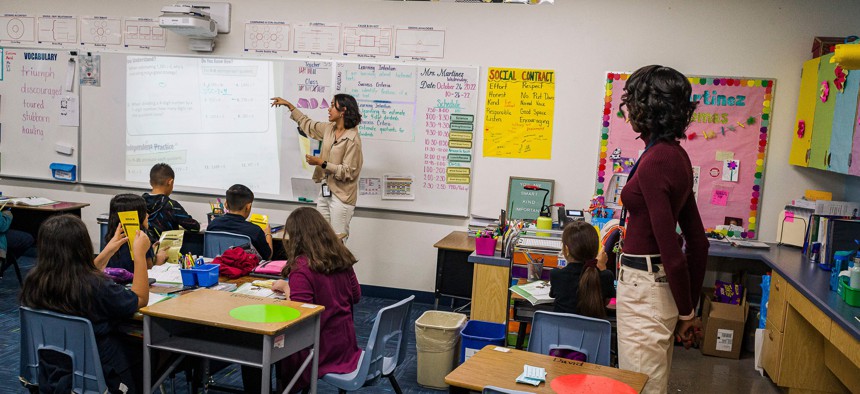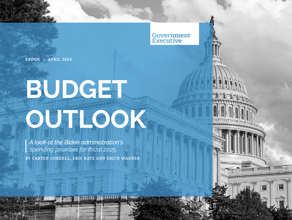Apprenticeship programs are growing as the public sector faces workforce shortages
Registered apprenticeships, infrequently used by state and local governments in the past, are gaining the attention of staff-starved agencies.
While public sector apprenticeships have long flourished in other countries like Germany, the United Kingdom, France, Switzerland and Australia, the vast majority of U.S. cities, counties and states have done little in the past to promote this kind of formal job training approach for their own employees.
But registered apprenticeships are finally beginning to gain traction in state and local governments. There have been dramatic increases in funding and in appreciation that apprenticeships are a powerful means for providing experience and mastery of needed skills. According to the U.S. Department of Labor, the number of apprentices in both the public and private sectors rose 64% between 2012 and 2021, with continued growth likely due to workplace shortages and massive training needs.
“Registered apprenticeships level the playing field and open the pipeline to untapped talent pools that previously wouldn’t be hired,” says Gina Robison, program supervisor for Apprenticeship Idaho. “It gives employers the opportunity to hire for aptitude rather than degree because the apprentice is entering into a training program and not as a fully skilled employee.”
A registered apprentice is considered to be an employee just like any other in the department. The length of an apprenticeship depends on the job. Anyone can call a newly hired trainee an apprentice, but registered apprenticeships must follow standards set by the applicable registration entity—either the federal Office of Apprenticeship or a state apprenticeship agency. According to those standards, apprentices are entitled to all the benefits received by other employees; they are supported by on-the-job mentors; have established well-delineated training requirements; and have preset guaranteed wage increases attached to either the mastery of skills required for the job or the completion of a predetermined number of training hours.
For a little less than half the states, the federal government is directly responsible for oversight of registered apprenticeship programs. Slightly more than half are overseen by state agencies, though they must still follow federal regulations.
What’s Held Apprenticeships Back?
While some states, like California, have been more active in promoting apprenticeships for their own employees, the majority have paid little heed to the potential of this hiring and training tool. In the past, several factors have restrained public sector apprenticeship development.
For one, apprenticeships have long been dominantly associated with construction workers and practitioners of a variety of trades such as plumbers, electricians and carpenters. But this stereotype can lead public sector entities to miss out on the idea that they can be used in a broader swath of jobs.
In addition, subpar communication between labor and human resources officials in siloed departments can limit opportunities for utilizing apprenticeship programs. “Sometimes conversations about apprenticeships leave out HR,” says John Marotta, senior policy associate in the Center on Labor, Human Services, and Population at the Urban Institute. “But if you don’t change your HR policies, none of this is going to happen. HR has to be at the table.”
Spreading the Word
The Urban Institute and The Council of State Governments, or CSG, are two organizations that have been actively involved in educating interested public sector entities about registered apprenticeships, offering technical assistance and establishing strategies for eliminating barriers that have blocked development before. Their work—along with philanthropic support and state funding increases—has contributed to “definite momentum.” says Marotta.
In 2022, Colorado Gov. Jared Polis signed an executive order expanding the number of registered apprenticeship programs within state government. On Sept. 23, he signed another executive order upping his goals for the state and directing departments to work with the Division of Human Resources and the Office of the Future of Work to increase the number of registered apprenticeship programs in departments by 50% by June 30, “with a preference for programs in classifications with high vacancy rates or in-demand occupations.”
Other places where legislative and executive leadership has helped to spark movement include the District of Columbia, Maryland and Maine, where Gov. Janet Mills designated $12.3 million in American Rescue Plan Act funding for the state’s apprenticeship programs, an amount supplemented by grants from the federal government and other sources. Prior to this influx of cash, the general fund budget devoted to apprenticeships generally hovered around half a million dollars, according to Joan Dolan, the director of apprenticeship and strategic partnerships for the Maine Department of Labor.
The $12.5 million goes to both private sector and public sector apprenticeships. But Maine, like Idaho, is part of a six-state CSG consortium that was started two years ago to encourage governments to expand apprenticeship use in their own governments. Both states are seeing particular benefits for small towns and rural school districts. “With a formalized training program, you’re not losing your students to the larger more urban areas for schooling. This is a way to retain talent in a small town. Apprenticeships can help you grow your own,” says Robison.
As leaders become increasingly aware that apprenticeships can be used for jobs outside of the skilled trades, their value accelerates. In Maine, for example, the Department of Health and Human Services has started an apprenticeship program to train nurses for its psychiatric hospitals, and six school districts in Southern Maine have hired apprentice teachers, with another round of funding for additional school districts planned. New apprentices are also being hired for the Maine Marine Patrol.
One of the ways that both public and private sector apprenticeship programs expand is through intermediary organizations, which are often supported by the states or the federal government. They act as liaisons between apprenticeship offices and potential employers to provide information, handle paperwork and make the task of setting up an apprenticeship program easier. “It really comes down to capacity,” says Dolan.
Leadership in Maine wants to spread the word to a growing number of localities and has been talking with the city of Augusta and other municipalities about becoming intermediary organizations. “I think once we can get some municipalities interested, the other ones will figure it out and then go, ‘Oh, wait. I want that, too,” Dolan says.
The Challenges
Setting up an apprenticeship program can be time consuming, so short-staffed and stressed organizations often lack capacity to pursue a solution they perceive as complex and potentially bureaucratic.
Another impediment to apprenticeships is state and local classification systems. “There are all kinds of challenges around how you classify apprentices and which existing classifications are appropriate for use because apprentices have few to no minimum qualifications,” says Mary Wurtz, policy analyst for CSG.
There’s also the problem of wage progression, which may differ from the rules that apply to non-apprentice employees. “If wage increases are tied to the acquisition of skills, what about the trainee who isn’t in an apprenticeship program and is not getting the same benefit?” asks Wurtz.
But there are solutions to these challenges. Some states are dealing with classification problems, for example, by creating a separate apprenticeship class rather than trying to work within the existing framework.
In the end, the way to get more governments to consider this option involves simply getting the word out and having governments see what their peers are doing. “There is a lot of confusion still,” says Robison, with “the needle moving slowly in the right direction.”




